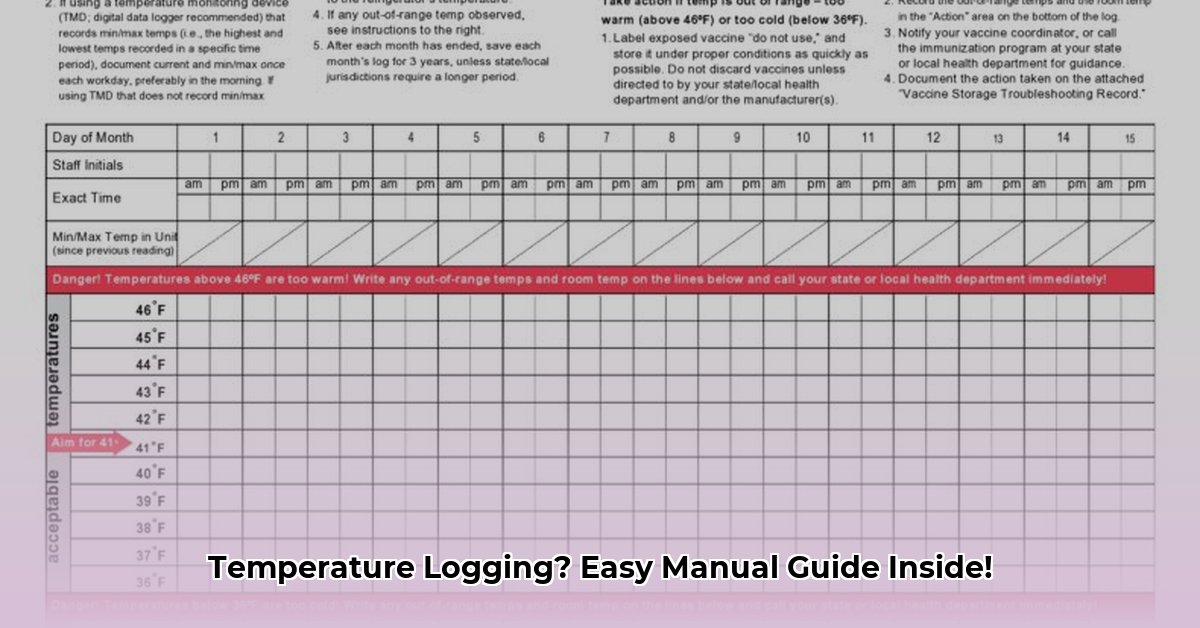Choosing Your Temperature Logging Method
Maintaining accurate temperature logs is critical in various industries, from food service to pharmaceuticals. This guide provides a comprehensive overview of manual temperature logging methods, including physical posting, digital uploads, and manual data entry. We’ll cover best practices, troubleshooting tips, and the importance of manual records in a digital world.
Why Manual Logs Are Still Essential
In today’s digital age, manual temperature logs remain a vital safeguard. They serve as a crucial backup during technology failures, such as power outages or software glitches. For smaller operations, manual logs offer a simple, cost-effective solution. Moreover, specific regulations in certain industries may require manual logs for particular processes.
Understanding Relevant Regulations
Temperature logging regulations exist to protect consumers and ensure product quality and safety. For example, the FDA Food Code outlines specific requirements for food temperature logging. Healthcare settings also have stringent guidelines, often based on CDC recommendations. This guide provides general information and is not a substitute for legal advice. Always consult official sources like fda.gov and cdc.gov for the most current regulations.
Physical Posting: Step-by-Step Instructions
This section details the traditional method of physically posting temperature logs.
Gathering Your Materials
- Log Sheets: Choose pre-printed templates, gridded paper, or design custom sheets based on your needs. Consider the frequency of recordings and expected temperature ranges when selecting a layout.
- Clipboard: Select a durable clipboard large enough to securely hold the log sheet. Weather-resistant clipboards are recommended for outdoor use.
- Bulletin Board: Choose a highly visible and easily accessible location for the bulletin board. Securely mount the board to prevent accidental detachment. Consider lockable covers for added security.
Setting Up Your Station
- Mount the Bulletin Board: Ensure the board is firmly attached to the wall in a visible location.
- Secure the Clipboard: Use clips, hooks, or magnets to attach the clipboard firmly to the bulletin board, allowing easy access for recording.
- Display the Log Sheet: Place the log sheet in the clipboard, ensuring it is clearly displayed and easy to read. Add a “Temperature Log” label for clarity.
Best Practices for Recording
- Use Permanent Ink: Choose a pen that writes clearly and doesn’t smudge.
- Maintain Legible Handwriting: Ensure entries are neat and easy to interpret.
- Establish Consistent Timing: Create a regular logging schedule and adhere to it.
- Initial and Date Entries: Document each entry with initials and the date for accountability and traceability.
Regulatory Compliance
Regulations regarding temperature log retention vary. Consult with local authorities or industry associations to ensure compliance. This article does not provide legal advice.
Troubleshooting
- Log Sheet Falling Out: Use a stronger clipboard or a more secure attachment method.
- Ink Smearing: Switch to a quick-drying pen.
- Hard-to-Reach Board: Relocate the board or use a step stool for safe access.
Digital Posting: Uploading Temperature Logs
This section covers uploading temperature logs to digital systems.
Manual Data Entry
- Gather Readings: Collect temperature data from your device.
- Open Spreadsheet: Use a spreadsheet program (Excel, Google Sheets, etc.).
- Create Columns: Set up columns for date, time, and temperature.
- Input Data: Carefully enter readings, double-checking for accuracy.
Extracting Data from Files
- Locate Files: Find the data files on your device (often .txt or .csv).
- Open the File: Open the file to view the data.
- Import Data: Copy and paste or use the import function to transfer data to your spreadsheet.
Using Intermediary Software
If your device and online system are incompatible, intermediary software can convert the data into a usable format. Research options online and ensure compatibility.
Troubleshooting
- Typos: Double-check entries for errors.
- File Format Errors: Use a compatible file format (often .csv).
- Data Misalignment: Ensure proper column alignment when copying and pasting.
Choosing a Digital System
| Feature | Manual Logging | Digital Posting |
|---|---|---|
| Cost | Low | Varies |
| Reliability | High (no software dependency) | Dependent on System Stability |
| Flexibility | High | Can be limited by system features |
| Time Investment | Higher | Potentially Lower |
| Data Security | Dependent on Physical Storage | Dependent on System Security |
| Accessibility | Limited | Potentially Accessible from Anywhere |
The best approach depends on your specific needs. Research different systems to find the best fit.
Manual Data Entry: Best Practices
Even with automated systems, manual data entry is valuable for validation and backup. This section focuses on accurately inputting temperature data into digital systems.
Ensuring Accurate Readings
- Calibrated Thermometer: Use a calibrated thermometer for accurate measurements.
- Consistent Timing: Record readings at the same time each day to minimize the impact of temperature fluctuations.
- Specific Location: Note the precise location of the measurement.
- Legible Records: Maintain clear and readable records to prevent misinterpretations.
Manual Data Entry Steps
- Record Temperature: Note the reading on paper or a notes app.
- Access Digital System: Log in to your chosen system.
- Navigate to Entry Point: Find the correct location for the entry.
- Input Reading: Carefully enter the temperature, verifying units.
- Save/Submit Entry: Save the data according to the system’s procedure.
Choosing Digital Tools
| Tool | Pros | Cons |
|---|---|---|
| Spreadsheet | Free/low cost, readily available, easy to learn | Error-prone, limited analysis, no audit trails |
| Dedicated Software | Powerful features, data visualization, audit trails | Can be expensive, may require training, compatibility issues |
| Cloud-Based Platform | Accessible, automatic backups, collaboration | Subscription fees, requires internet, data security considerations |
Addressing Data Entry Challenges
- Incorrect Entries: Correct the entry directly or consult help documentation.
- Suspicious Readings: Check thermometer calibration and environmental factors. Retest for consistency.
- Data Gaps: Reconstruct missing data if possible, or document the gap and the reason.
Conclusion
Manual temperature logging remains an essential practice, providing a reliable backup and ensuring data integrity. By following best practices and utilizing the right tools, you can maintain accurate and compliant temperature records. While technology continues to advance, manual methods are likely to remain relevant for the foreseeable future, particularly in regulated industries and as a safeguard against unforeseen technological disruptions. Share your own tips and experiences in the comments below!
- Hydropower Drink Fuels Motocross Riders, Combats Arm Pump - December 18, 2025
- Hydropower Technology Innovations Drive Future Of Renewable Energy - December 17, 2025
- Water Mill Electricity Generator Provides Free Home Power - December 16, 2025
















